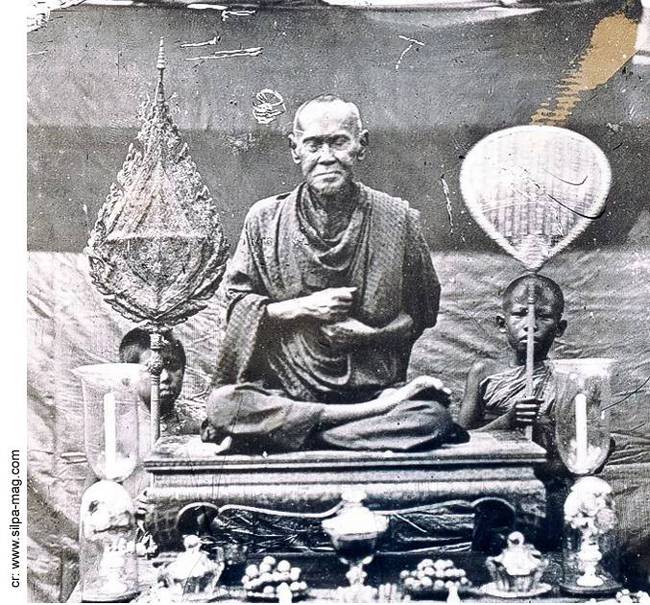Wiki Phra Somdej International
维基顺德瓦拉康寺佛牌 by Lek Watruak
维基顺德瓦拉康寺佛牌 by Lek Watruak

Somdej Toh***(B.E.2331-2415), the creator and blesser of the famous Somdej Wat Rakang (SWRs)
Why Must
PAS Somdej Wat Rakang ?
Collecting styles of Somdej Toh's Somdej Wat Rakang (SWRs) today can be divided into two main standards:
1) Traditional Approach Standard (TAS)
2) Preservational Approach Standard (PAS)
1) The TAS has old standard adhered to traditional criteria for evaluating SWRs. These criteria have been practiced since after World War II.
SWRs in this standard come from three temples: Wat Rakang (5th molds), Wat BangKhunPhrom or Wat MaiAmataros (9th molds), and Wat Keschaiyo (3 molds).
The primary focus of the TAS is "locking" on the DESIGN and CONTENT (texture) of SWRs, while giving less important to holy MATERIALS mixed in the amulets. The TAS adhered to the idea that if the imprint (mold) of a SWR and its content (texture) are accurate or correct, whether it has holy materials or not - it does not matter.
The TAS use only 10x magnified lens as the crucial instrument to evaluate any SWRs. They use less powerful and no high-tech instrument to evaluate SWRs that caused some fake or uncertain items of SWR have been sold.
The TAS's SWRs are in limited circulation, with approximately 400-500 pieces have been appeared in the amulet market so far. To acquire one, individuals need to purchase it from those who possess them. As the result, the price of these SWRs are on non-stop rising due to the limited availability and high demand.
This is the reason why the price of TAS's SWRs is going up high and higher to reach multi-million THB level.
2) The other SWR collecting style is known as the Preservational Approach Standard (PAS) or called in Thai as Sai Anurak. It is named as such because collectors of this group collect SWRs that have clear and reliable document support on their creations.
The PAS collectors aim to preserve or maintain the existence of those original SWRs.
PAS GAINS HIGHEST POPULARITY
The PAS was gradually established several years ago and has now become the main group of collecting SWRs with the highest popularity in the country.
The PAS uses a 10x magnifying lens for initial examination and use a high-powered microscope for further reliable and accurate examination.
This makes the PAS gains a high credibility on SWR evaluation that leads so many and many collectors nationwide following this approach.
The PAS places great importance on MATERIALS, CONTENT (texture), and MOLD (Phim) of a SWR.
SOMDEJ TOH'S 50 YEARS ON
SOMDEJ AMULETS CREATIONS
Many scholars and collectors in the PAS have extensively studied so many documents and found that Somdej Toh created SWRs from the year B.E. 2365 to 2415, spanning around 50 years. Somdej Toh created his holy amulets on various significant ceremonies, a total of 14 times, with 84,000 pieces created for each ceremony.
Apart from that, Somdej Toh also created SWRs almost every day to distribute to people, with the help of monks in the temple and royal artisans who assisted in the creation processes. Some of these SWRs were preservedly stored in more than 10 different temples to maintain Buddhism.
The main materials used in creating those great SWRs were powdered seashell mixed with around 20-30 other ground additives. These materials were commonly found in surrounding areas, but there are several key materials that are common or the same which plays an important role in evaluating SWRs.
There are clear documentary evidences that Somdej Toh created a vast number of SWRs. This makes the PAS's SWRs having inexpensive price, which is beneficial to collectors directly.
ORIGIN SOURCE OF ALL
SOMDEJ AMULET MOLDS
It is worth noting here that while Somdej Toh was still alive, Wat Rakang was the origin source of all Somdej amulets' molds. All of many master molds were originally carved by royal artisans and so many duplicated molds were also produced concurrently for making Somdej amulets.
Samien Traduang, a layman disciple of Somdej Toh, requested molds for making Somdej amulets to store in Wat BangKhunphrom. Somdej Toh gave him duplicated molds for Somdej amulets making. For Somdej Keschaiyo of Wat Chaiyo, AngThong province, all 3 molds of Somdej amulets were made at Wat Rakang and brought upstream to Wat Chaiyo for storing there.
PAS MAKING GREAT STRIDES
The PAG has made significant progress on SWRs' evaluation due to using scientific and technological instrument for evaluating each SWR. So, this is why the PAS is widely and internationally accepted.
The PAS's verification on SWRs is most popular at the moment in among collectors all over the country.
Please note that the evaluation criteria for SWRs between the Traditional Approach Standard (TAS) and the Preservational Approach Standard (PAS) differ. If you are seeking knowledge or information about a SWR, you must go to the correct pathway because each group has different criteria on evaluating.
And please note that all the SWRs appeared on www.wikiphrasomdej.com and other related internet media platforms are of the Preservational Approach Standard (PAS) or Sai Anurak in Thai.
.
*** Somdej Toh is a short and simple term for Somdej PhraPhutdhajahn (Toh Phromrangsie), the early-period abbot of Wat Rakang who created and blessed the famous Somdej Wat Rakang (SWRs).
Copyright © Lek Watruak
Home
